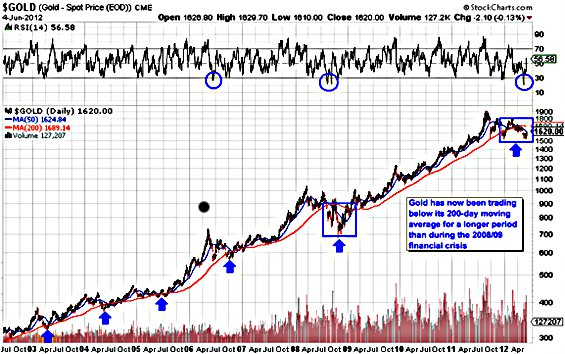
Gold has fallen out of favor and many analysts have stuck a fork in the gold bull. When stocks are up they say the risk trade is on and nobody wants to hold a safe-haven asset that does not pay interest. When stocks are down they rush to the perceived safety of U.S. dollars or bonds, dumping gold along with everything else. From their perspective, there is never really a good time to own gold.
I have encountered a similar scenario with friends and family. When gold was trading at $1,900/ounce (oz), they thought they were too late and complained about missing the boat. Now that gold has corrected to below $1,600/oz, they believe it is no longer a good investment and that the bull market may be over. Again, there is never a good time to invest in gold from their perspective. It is either too high or too low, so might as well stay away from the barbaric relic. Fear dominates the psyche of most investors, which is why they are sitting on the sidelines with negative real gains in the past decade.
Central Bank Price Suppression?
Many naysayers observe that the precious metals market is rigged and claim that you can't possibly win against the central bankers. They are too powerful and will certainly keep a cap on the price of gold and silver. After all, they can crush the market with paper leverage at anytime, right?
Yet, gold has risen from $300/oz to $1,600/oz in the past decade for a gain of more than 400%. If you sold at $1,900/oz, you would have realized a gain of nearly 550%. Meanwhile, silver has gone up 10x from $5 to $50/oz in the same time period, before correcting to $30, or a gain of 500%. Many of our favorite mining stocks are up well over 1,000% during this time period, even with the sharp correction we are currently experiencing.
So, by any measure the central bankers have been an abysmal failure at suppressing the price of precious metals. They can trash the price on a daily basis and keep a lid on advances in the short-term, but they have been woefully inept at any attempts at medium or long-term price suppression. Furthermore, many believe they may soon be exiting the manipulation game, with heavy losses mounting, U.S. Commodity Futures Trading Commission (CFTC) scrutiny and new exchanges opening in Asia to offer better price discovery.
Quite contrary to claims of there never being a good time to buy, you would be sitting on incredible profits no matter what time you bought over the past decade, with the exception of the past nine months. And even if you bought in this time period, I believe your positions will soon be in the green.
Going Against the Herd
Sentiment has turned very negative towards precious metals recently. It can be incredibly difficult to go against the herd (herd mentality). We are all connected energetically and so we feel a natural urge to go with the flow of our fellow man. But this is exactly the wrong thing to do in the investment world and particularly within the precious metals sector. The most successful investors muster the courage to buy when everyone else is selling and sell when everyone else is buying.

This contrarian outlook has been famously expressed in a multitude of ways, yet few actually heed the words.
"Investors should remember that excitement and expenses are their enemies. And if they insist on trying to time their participation in equities, they should try to be fearful when others are greedy and greedy when others are fearful."—Warren Buffet
"The time to buy is when there's blood in the streets." —Baron Rothschild
"Whenever you find yourself on the side of the majority, it's time to pause and reflect."—Mark Twain
"The 'crowd' is most enthusiastic and optimistic when it should be cautious and prudent; and is most fearful when it should be bold." —Humphrey Neill
Yet here we are in the midst of another correction in the gold market and so many investors are sitting on the sidelines paralyzed with fear. Others may be waiting in an attempt to perfectly time the bottom, but this is a fool's errand. The better approach is to start averaging in during times like this, spacing out your purchases into several tranches over a defined time period. And I believe right now is an excellent time to start doing so, if you haven't already.
Friday's Price Action Marks Significant Shift for Gold
The recent price action in the gold market is very bullish for a number of reasons and I believe that we have most likely seen the bottom for this correction. This conclusion is not derived solely from the strong gold rally on Friday, but the defining characteristics of this rally:
- Gold decoupled from the dollar and advanced despite the dollar rising. In other words, the advance in the gold price was driven by an increase in demand from buyers, not simply a reflection of a falling dollar.
- Gold decoupled from the stock market and advanced despite stocks plunging. Gold and silver often fall when stocks take a large hit, as investors scramble for liquidity and throw out the proverbial baby with the bathwater. On Friday, investors sold stocks and bought gold. This means that gold is now being viewed by an increasing number of investors as a safe-haven asset or put another way, as money. This is a huge shift from the 2008 financial crisis and signals that the market is losing faith in U.S dollars and bonds as a safe place to park assets.
- Gold closed Friday near its high for the day and closed strong into the weekend. Strong closes add weight to the day's move and when it occurs on a Friday, demonstrates that investors are willing to hold over the weekend.
Gold's correction is now entering the tenth month, which is longer than the average duration for corrections over the past decade. It also remains technically oversold, trading below its 200-day moving average, a condition that has only occurred a few times in the past ten years and never persisted very long. In fact, the only time that gold traded below its 200-day moving average for any substantial period was during the 2008 financial crisis. Gold has now traded below this level for longer than it did during the depths of crisis, despite the absence of any full-blown crisis at present.

You will also notice from the chart above that this is only the second time that the RSI has traded significantly below the 30 level. By any measurement, we can conclude that the current correction is very overblown and likely to be completing soon, if it hasn't already bottomed.
So, either this time really is different and we are completely missing some mystery catalyst that has ended the gold bull market, or we have bottomed and should be backing up the truck? It is up to you to decide which is true, but I have yet to identify a single fundamental that has turned against gold in the past year. To the contrary, every fundamental reason for gold's rise has only become stronger and if recent calls for new stimulus by Boston's FED President Rosenberg are heeded, gold may be preparing to rocket higher.
The only potential short-term negative for gold is the euro crisis. If we see the failure of a large bank and sovereign defaults, gold could get taken down one more time in a rush to liquidity. But it seems inevitable that any such crisis will be met with new and unprecedented levels of monetary stimulus, easing and massive bailouts. Of course, this response is extremely bullish for gold, which is why I say that this threat to the gold price is only short term in nature.
However, if Friday's action is indicative of future moves by investors, gold may not get dumped to the extent that is was during the 2008/2009 financial crisis. After all, what is the point of selling if there is a high degree of probability that more stimulus and bailouts will follow to prop up the market once more?
Conclusion
Given Friday's action, strengthening fundamental and technical signals, our analysis of past corrections and the increased likelihood of new stimulus in the near future, I believe that right now is an opportune time to start averaging into new positions or increasing current positions. Conservative investors may prefer to wait for action from the central banks, but they risk missing a good part of the move up. In my opinion, the downside risk is very minimal at this juncture.
Gold needs to climb to $2,400/oz and silver to $150/oz to reach the inflation-adjusted highs of 1980. Considering that the fundamentals are even stronger now than they were back then, we can expect these numbers to be easily exceeded. John Williams of Shadowstats.com went through the trouble of stripping out the government gimmicks and calculating the true inflation-adjusted highs for gold and silver. His analysis concludes that gold would need to reach $8,890/oz and silver would need to hit $517/oz to match the highs of 1980!
If my analysis is correct and John's numbers are anywhere close, there is a huge move coming for gold and silver. Whether you buy at $1,600 or $1,800/oz will be of little consequence a year from now. The important thing is to get aboard before the train leaves the station.
I am personally buying both physical metals and undervalued mining stocks at this time. I believe that junior miners are currently offering the best entry points of any time since the start of this bull market.
Jason Hamlin
Gold Stock Bull



























































